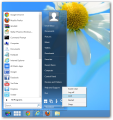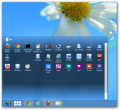Microsoft plans to reach RTM (Release to Manufacturing) with Windows 8.1 in August, and one thing is certain about the start button: it is not coming back to Windows just yet.
Luckily, there are plenty of third-party developers ready to supply users with a different version of the launcher that in some cases substitutes the original perfectly.
RetroUI is one of the several solutions when it comes to adding a launch button at the end of the taskbar in Windows 8 and 8.1.
(the developer posted a comment below informing that at the time of writing RetroUI does not officially support Windows 8.1 OS due to some issues with Enforce feature).
However, it introduces a different approach as it features two launchers, one for the desktop applications and one for accessing modern apps, called TabletView, which comes in handy when Windows is controlled by touch.
RetroUI is available at a $4.95 / 3.85EUR price or you can take it for a spin free of charge for a period of seven days. The installation routine is simple and takes you through the regular screens, nothing being out of the ordinary.
At the end of the process, the new elements should have taken its place, but in our case it failed to do so. The developer is aware of this behavior, and at the end of installation a dialog pops up instructing on what should be done in order to see the buttons.
Right from the start, we noticed that both menus offer access to the same resources, but the main one can also open specific locations on the system and makes available the power button options (shutdown, restart, sleep, lock, log off, switch user).
The main start button (it responds to pressing Windows key) in RetroUI resembles what Microsoft created for Windows 7, but it is not exactly the same. In terms of functionality the two are miles apart.
The original in Windows 7 is dynamic in listing the shortcuts as it moves the most frequently used entries into a more visible position. Furthermore, it sports Jump Lists for accessing recent items and the search happens as you type.
RetroUI failed to show such kind of flexibility during our tests as it listed shortcuts for modern apps as well as a few more important locations (Computer, the libraries), Notepad and Calculator; search results occurred with a slight delay and, depending on the query, sometimes the application became non-responsive.
On the other hand, this button is the easiest way to view the entire list of recently accessed items on Windows 8.
You can change the program list by pinning new items or removing existing ones. This involves searching for the particular entry and right-clicking it to access the option; but as mentioned before, the search function did not work smoothly in our case.
Whatever you pin in the main menu is automatically reflected in TabletView. Whatever you pin in the main menu is automatically reflected in TabletView. Its main purpose is to provide quick access to apps when using Windows 8 in touch mode.
RetroUI comes with Enforce, a feature similar to Stardock’s ModernMix, that enables Windows taskbar when the modern Start Screen pops up, and it also forces modern apps to run into a resizable interface.
Although resizing their frame is easily achieved by dragging by one of the corners, there is also the possibility to deploy them with a preset size, defined in percentile, from Enforce’s configuration options.
Basically, these programs act as regular, desktop ones and support snapping to the edge of the screen.
Customizing RetroUI to suit your needs is pretty easy and the options include changing the style of the start menu and giving it a modern touch (resources are organized in tiles) or by defining the maximum number of items that can be pinned.
There is also the possibility to modify how the search button (not the search bar under the list of programs) reacts: search using Explorer, the apps or files (Windows 8 style).
Additional settings in the configuration panel refer to the functionality of Enforce feature. The choices at hand allow enabling edge-snap, saving the window position for modern apps or enabling the system tray icon.
During our testing, RetroUI seemed like a half-baked product. The start menu is not exactly mimicking the functionality of the original in Windows 7 and it does not bring anything new to fill the gap.
The Good
It is not difficult to figure out what each setting does and it can force modern apps to run into a resizable frame, with specifics configurable by the user.
The taskbar is visible even when the Start Screen is displayed.
TabletView button works mostly like the start menu, but it is designed for handling in touch mode.
The Bad
The switch between a resized modern app and the classic desktop or a regular window is far from seamless. Enforce failed to impose the same size restrictions to all modern apps.
 14 DAY TRIAL //
14 DAY TRIAL // 










